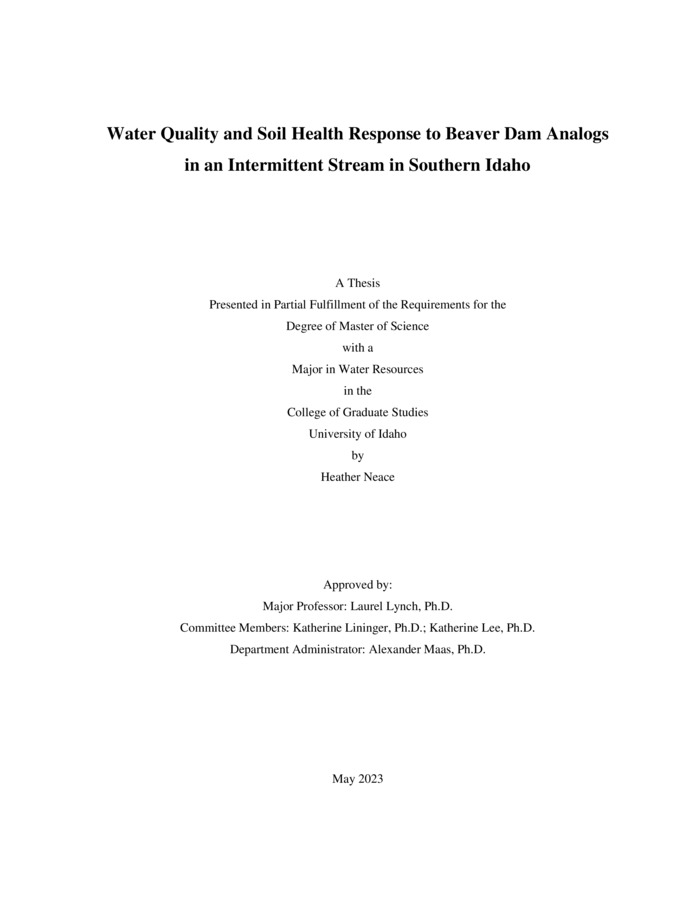Water Quality and Soil Health Response to Beaver Dam Analogs in an Intermittent Stream in Southern Idaho
Neace, Heather. (2023-05). Water Quality and Soil Health Response to Beaver Dam Analogs in an Intermittent Stream in Southern Idaho. Theses and Dissertations Collection, University of Idaho Library Digital Collections. https://www.lib.uidaho.edu/digital/etd/items/neace_idaho_0089n_12622.html
- Title:
- Water Quality and Soil Health Response to Beaver Dam Analogs in an Intermittent Stream in Southern Idaho
- Author:
- Neace, Heather
- ORCID:
- 0009-0000-0773-9535
- Date:
- 2023-05
- Keywords:
- arid land beaver dam analog rangeland restoration riparian soil water quality
- Program:
- Soil & Water Systems
- Subject Category:
- Water resources management; Soil sciences
- Abstract:
-
Beaver dam analogs are gaining interest in the Northwestern United States as a restoration technique to enhance riparian health to enhance resilience to increased drought because they are an accessible technology. Beaver dam analogs have been shown to provide the same benefits as natural beaver dams such as increased surface water storage, sediment aggradation, reduced stream channel incision, increased floodplain inundation, and increased hyporheic exchange. Intermittent streams make up for more than half of all streams in the United States and have further decreased flow in response to low snow melt and higher temperatures earlier in the season attributed to global warming. Beaver Dam analogs were installed in an intermittent system on rangeland in Southcentral Idaho in three treatment clusters with a reference reach upstream. Water and soil samples were taken in the summer of 2021 pre-installation of beaver dam analogs to establish baseline conditions and samples in 2022 represent the first water year within the stream with the structures. Significant drought occurred in both seasons with water flowing until May and water present in some locations until early July. Stream temperature, phosphate, nitrogen, and dissolved oxygen were monitored to assess whether beaver dam analogs could increase eutrophication risk. All constituents showed no significant change in comparison to the reference meadow, therefore beaver dam analogs did not affect eutrophication risk within this system. Soil samples were taken in two locations in each reach (reference, meadow 1, meadow 2, and meadow 3) at 2, 4, and 6 feet from the stream channel to observe lateral change in biogeochemical parameters. Carbon and nitrogen stocks had no significant changes. Microbial biomass in 2022 samples were significantly higher compared to 2021 in all locations. Soil Moisture also increased in all locations, the correlation between higher microbial biomass due to increased soil moisture is clear because of the consistency throughout the reference and treatment meadows. Our findings indicate little change within one water year but show promise in increasing soil process efficiency through wetting events if enough water is supplied to spill onto the floodplain.
- Description:
- masters, M.S., Soil & Water Systems -- University of Idaho - College of Graduate Studies, 2023-05
- Major Professor:
- Lynch, Laurel M
- Committee:
- Lininger, Katherine B; Lee, Katherine D; Maas, Alexander
- Defense Date:
- 2023-05
- Identifier:
- Neace_idaho_0089N_12622
- Type:
- Text
- Format Original:
- Format:
- application/pdf
- Rights:
- In Copyright - Educational Use Permitted. For more information, please contact University of Idaho Library Special Collections and Archives Department at libspec@uidaho.edu.
- Standardized Rights:
- http://rightsstatements.org/vocab/InC-EDU/1.0/

